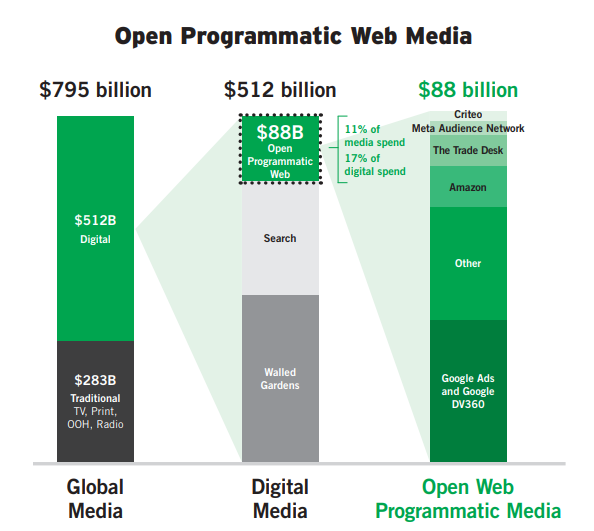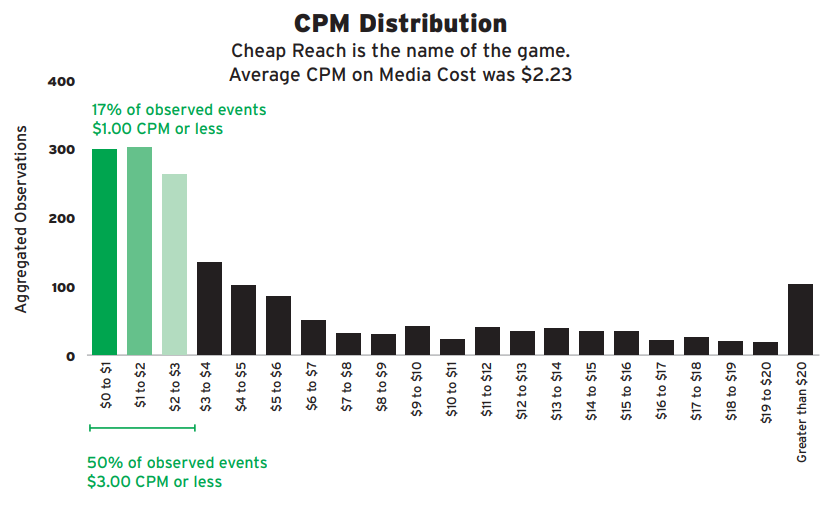Made for Advertising (MFA) websites represent 21% of impressions and comprise 15% of spend.
That is according to the Association of National Advertisers (ANA), which has conducted its first programmatic media supply chain transparency study to examine challenges in advertising on the open web.
The report’s draft findings, seen by The Media Leader and due to be presented at Cannes Lions today, show significant waste in online adspend. Apart from the “startlingly” high amount of expenditure going toward MFA sites (which typically use sensationalist headlines, clickbait, and other low-quality and provocative content to attract visitors), the study found the average campaign runs on 44,000 websites, an amount it called “deeply concerning.”
“It is hypothesised that the ‘long tail’ of the web adds minimal reach yet likely performs badly in areas such as fraud, viewability, and brand safety, assuming such issues can even be measured there,” the study reads.
Open programmatic advertising is estimated to be an $88bn global market. Given the lack of efficiency found by the ANA, the trade body is confident course correcting improvements, such as reducing spend on MFA sites, could lead to at least $20bn in efficiency gains within the sector.

A reduction in wasteful programmatic could also significantly enhance sustainability efforts. According to Scope3, MFA sites have 26% higher carbon emissions than non-MFA inventory.
Cheap doesn’t equal quality
Roadblocks currently exist to improved efficiency, however. The ANA found that there are “severely misaligned” incentives in the open programmatic market, wherein advertisers are prioritising cost over value. They do so “at their own detriment,” says the report, as not all inventory or impressions should be considered equal.
“Common sense should tell buyers that not all ‘cheap’ inventory is ‘quality’ inventory,” it reads. And yet, half of all observed open programmatic buys were $3.00 cost-per-thousand (CPM) or less.

The ANA recommended advertisers better balance their pursuit of low-cost inventory with higher quality programmatic buys. Namely, advertisers should seek viewable, fraud free, and brand safe inventory, even if it comes at a cost premium. Doing so would reduce waste and improve efficiency.
Ways to accomplish this could include prioritising the creation of website inclusion lists, as opposed to exclusion lists. Doing so would help streamline the number of websites used, thereby cutting down on waste. Care must be taken, the ANA noted, to ensure any reduction is both fair and equitable for small or minority-owned or minority-targeted service provides and the audiences they deliver.
If using exclusion lists, the ANA recommended advertisers demand that MFA sites be excluded from a media buy unless they are specifically wanted or needed. In addition, advertisers should only use partners where quality metrics are available.
Manning: The ANA’s media transparency redux and the need for more honesty
‘Unknown delta’ virtually eliminated?
The ANA’s study is similar in scope to the recent ISBA/PwC studies of the past three years. In its original 2020 Programmatic Supply Chain Transparency Study, ISBA/PwC identified an “unknown delta” of unattributable adspend equalling 15% of all programmatic media. In its follow-up 2023 study, ISBA/PwC reduced its “unknown delta” estimate to 3%.
The new ANA study, which used a Full Path Log Level Data (LLB) analysis, claims it has “virtually eliminated” the delta, with the study writing that “the good news for advertisers is that this mysterious delta is not about missing money but about missing data capabilities.”
But transparency issues still plague the programmatic sector. Data access is lacking, as the ANA noted the majority of companies interested in participating in its study were unable to do so “as they were not able to make it through legal and other hurdles to get access to log data from DSPs, SSPs, and ad verification providers.
“While brands appear to have more access to data today, data gaps and lack of transparency still plague the programmatic space.”







